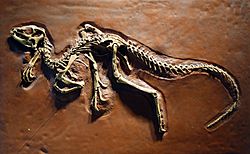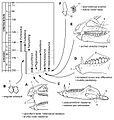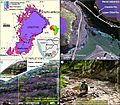Heterodontosaurus facts for kids
Quick facts for kids HeterodontosaurusTemporal range: Lower Jurassic
|
|
|---|---|
 |
|
| Cast of specimen SAM-PK-K1332, University of California Museum of Palaeontology | |
| Scientific classification | |
| Kingdom: | |
| Class: | |
| Superorder: | |
| Order: | |
| Family: | |
| Genus: |
Heterodontosaurus
|
| Binomial name | |
| Heterodontosaurus tucki |
|
Heterodontosaurus (say: Het-er-oh-dont-oh-sore-us) means "different toothed lizard." It was a small dinosaur that ate plants. This dinosaur had very special teeth, which is how it got its name!
It lived a long, long time ago, about 200 to 190 million years ago. This was during the Lower Jurassic period. Heterodontosaurus fossils have been found in South Africa. It was a relative of another dinosaur called Abrictosaurus.
What was Heterodontosaurus?
Heterodontosaurus was a small dinosaur. It walked on two legs. Scientists think it was about the size of a small dog. It was a herbivore, meaning it only ate plants.
Its Unique Teeth
The most interesting thing about Heterodontosaurus was its teeth. Most dinosaurs had only one type of tooth. But Heterodontosaurus had three different kinds!
- Front teeth: These were small, leaf-shaped teeth. They were probably used for nipping off leaves and stems.
- Canine-like teeth: These were long, pointed teeth, like the fangs of a dog. Scientists are not sure why a plant-eating dinosaur had these. Maybe they used them for defense. Or perhaps they used them to show off to other Heterodontosaurus dinosaurs.
- Cheek teeth: These teeth were at the back of its mouth. They were wider and flatter. They helped the dinosaur grind up tough plant material. This allowed it to get more nutrients from its food.
Where it Lived
Heterodontosaurus lived in what is now South Africa. During the Lower Jurassic period, this area was likely warm and had many plants. This would have been a good place for a plant-eating dinosaur to live.
Images for kids
-
African heterodontosaurid localities: Tyinindini, Voyizane, and Tushielaw denote Heterodontosaurus finds
-
Biogeographic distribution of heterodontosaurids in time
-
Reconstruction of jaw musculature and keratin sheathing of the beak
-
Stratigraphic context and locality maps of specimens AM 4766 and 65
See also
 In Spanish: Heterodontosaurus tucki para niños
In Spanish: Heterodontosaurus tucki para niños












